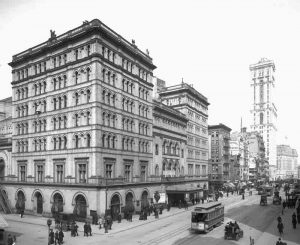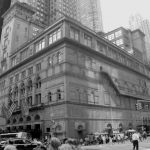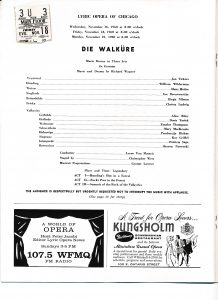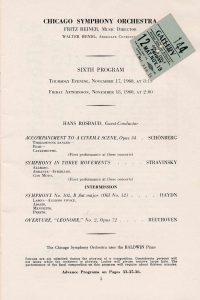Stories of Music
Act II
By James Macon Walton
Easter, 1958
Metropolitan Opera. New York
4 April 1958
Richard Wagner, Parsifal
Morosco Theatre. New York
4 April 1958
Jean Anouilh, Time Remembered
Metropolitan Opera. New York
5 April 1958
Gaetano Donizetti, Lucia Di Lammermoor
New York Philharmonic. New York
6 April 1958
Franz Joseph Haydn, The Creation
 |
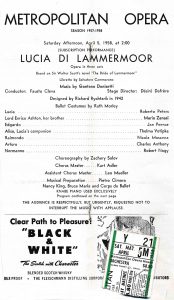 |
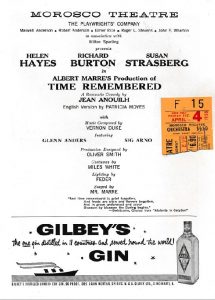 |
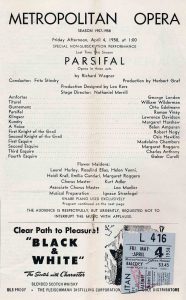 |
Ah, the things we do when we are young!
I began my undergraduate education attending Northwestern University in Evanston, Illinois, for the academic year 1956-57 and the first quarter in the fall of 1957. I then transferred to Hendrix College, Conway, Arkansas, from which I graduated with a B.A. degree in June of 1960. In September of 1960 I enrolled at the School of Law of the University of Arkansas in Fayetteville, Arkansas, from which I later graduated in June of 1963 with the degree of LL.B.
During the second semester of my sophomore year, at Hendrix College, I and three other of my fellow students hatched a plot. As the Easter vacation approached, we decided that it would be a fun thing to go to New York City for a jaunt. There would be a four-day holiday in the school schedule; perhaps even the dorms and dining hall would be closed. One of our group had a car so we planned to leave after classes on Wednesday and drive all night to reach New York by Thursday afternoon. We approached the Dean of Students with our “proposed” trip and asked that our time for our drive back, on the Monday following Easter Sunday (when we would still be in New York) be an excused absence. The Dean agreed that our trip could be considered “a valid educational experience” and approved our request.
I knew that the primary thing I wanted to do in New York was to attend performances at the Metropolitan Opera. By this time I had attended 16 operas, in Dallas, Memphis, Chicago, and one in Little Rock. Thus, when I learned that the performance at the Met, on Good Friday, was to be Wagner’s Parsifal, I felt I was ready for my first Wagner opera. Saturday afternoon’s choice was Lucia; since I had already seen/heard this opera I would have preferred a different, and for me new, selection, but I would take whatever performance I could.
One of the other of our group, Sammy, decided that he too wished to attend a performance of an opera at the Met. Since he had never before attended a performance of an opera, I felt that Wagner might not be the most appropriate introduction to opera for him. I tried to persuade him to have the Saturday matinee Lucia as his first opera, but he insisted on Parsifal as his initiation to opera. Accordingly, I arranged for a travel agent in New York, whom my father had used in the past for his travels, to purchase the Met tickets for us.
So, off we went. The trip to New York was tiring–the driver and “shotgun” in the front to help the driver stay awake, with the other two of us trying to sleep in the rear seat–but without incident, with the exception of the speed trap somewhere in Virginia. Luckily for us, another young man, a former graduate of Hendrix, was attending Columbia University and arranged for us to sleep in dorm rooms unoccupied during their Easter break.
Whatever else we did during this visit, my second to New York City, on Friday afternoon Sammy and I, having secured our tickets from the travel agent, found our way to the Metropolitan Opera (what we now refer to as “The Old Met House”). Our seats were in the top row of the top balcony, tucked high and far away from the stage. I remember nothing of note regarding the performance itself. What I do remember is that Sammy, at his first opera, his first Wagnerian opera, fell asleep.
Actually, I cannot really fault Sammy. We all were exhausted most of our time in the city. I myself was not immune to the effect of this condition. Sunday, for the performance of Haydn’s The Creation, at Carnegie Hall, barely into Part The First, after the Introduction and initial Recitative, the following Chorus began with a soft passage. I did not fall completely asleep, but I must have nearly dozed off, because when came the words “Let there be light,” in which the word LIGHT is presented with a full crescendo by both chorus and orchestra, I was jolted to life, if not light. I was well awake for the rest of the performance!
Having attended the Friday matinee performance of Parsifal, I elected to attend a play that Friday night. My choice was Jean Anouilh’s Time Remembered, selected not for the play itself but rather for the cast of that performance. I knew then, as I know now, that the cast, with Helen Hayes, Richard Burton, and Susan Strasberg, was exceptional. I remember no details of the play–only that I was experiencing what was for me a bit of cultural history.
Saturday’s opera was also a matinee. However, to date I have found no indication in my files as to what, if any, event I might have attended Saturday night. If I do find such information, I shall revise this article accordingly.
Lyric Opera of Chicago. Chicago, Illinois
18 November 1960
Richard Wagner, Die Walküre
Chicago Symphony Orchestra. Chicago, Illinois
18 November 1960
Lyric Opera of Chicago. Chicago, Illinois
19 November 1960
Giacomo Puccini, Tosca
In the previous article I noted my college undergraduate and graduate history. While studying at Northwestern I attended several performances at the Lyric Opera of Chicago. Even though I had left the Chicago area in December of 1957, from my new residences in Arkansas I monitored the seasons of the Lyric to see which operas were being performed there in these subsequent years. I also had a portable record player and had begun purchasing certain recordings, including several complete operas, one of which was Wagner’s Die Walküre. It was, therefore, with special interest when I learned that, in November of 1960, just after the start of my first year in Law School, the Lyric was to perform Die Walküre. It was even more of a delight to learn that the cast of the Lyric’s performance was to include three of the same singers (Jon Vickers, Gre Brouwenstijn, and Birgit Nilsson) who were in the cast of the recording I owned (RCA Victor LDS 6706), and, in addition, Hans Hotter and Christa Ludwig. Being young, and somewhat impetuous, I decided that this was a once in a lifetime opportunity. I purchased a ticket for this performance and made plans to travel to Chicago to attend it.
Fayetteville, Arkansas, in the far northwest corner of the state, was (and still is) far removed from major highways to Chicago. No railroad ran between the town and the city. I must have found that there was no practical way to make the trip by bus. My choice, thus, was to hitchhike!
As best I recall, I left Fayetteville after morning classes on Thursday, 17 November 1960. My rides took me north into southwest Missouri, then across that state east and north to Route 66. Somewhere there in the middle of the night I was picked up by two men in an older car. They were going all the way to Chicago. As I sat in the back seat, one of them mentioned cryptically that they “had had a spot of trouble back there.” Shades of In Cold Blood! I remember writing a note describing them and the car and hiding the paper in my clothing–so that it would be found with my corpse if it came to that. However, the most that happened was that they asked me to contribute to the cost of gasoline for the trip–which I was glad to do. Not only did they take me all the way to Chicago, but also they drove me to State Street, to the Palmer House, where, by coincidence, my parents were staying, my father being there to attend a meeting. My parents were greatly surprised, and, I am certain, not a bit pleased to have me arrive unexpectedly–and cutting classes–to use one of their beds to take a nap.
I have vivid memories of portions of this performance: (1) the Act One, Scene Three arias Winterstürme wichen dem Wennemond (Sigmund); Du bist der Lenz (Sieglinde); and Siegmund’s Siegmund heiss’ ich, with his freeing of the sword–Nothung! Nothung!–from the tree in Hunding’s hut; then (2) the Act Three. Scene One “Ride of the Valkyries” and the Scene Three end of the opera with the “Magic Fire Music.”
This performance of Die Walküre was everything I could have wished. Even now, nearly 60 years later, I know that I have not to date and could never hope in the future to attend another performance to equal the magical experience of that night. Hitchhiking 20 hours overnight to get to Chicago just made the whole event more worthwhile!
Having arrived in Chicago around 8:00 A.M., and after a nap in my parent’s hotel room, I ventured out to the streets of the city. My notes indicate that I spent some time at the Art Institute of Chicago, then crossed Michigan Avenue to Orchestra Hall for the Chicago Symphony Friday afternoon concert before the Friday night performance of Die Walküre. I am sure I welcomed the Schönberg, Stravinsky, and Beethoven, but would have preferred something other than the Haydn.
I stayed in town over Saturday night, and attended the Lyric’s performance of Tosca on the 19th (see my article re my first two performances of Tosca in the ACT I series under this heading). This was indeed as special a performance of Tosca, with a cast of Renata Tebaldi, Giuseppe di Stefano, and Tito Gobbi, as was the presentation the prior night of Die Walküre.

